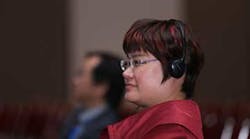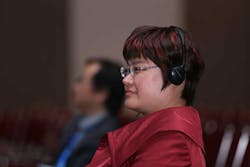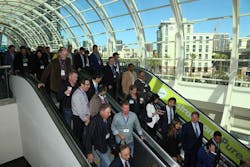Global presentations on implant dentistry from the AO: 10 key clinical takeaways
The Academy of Osseointegration Annual Meeting brings together clinicians from around the world in one location to share advancements and best practices in implant dentistry. This year’s meeting held February 17–20, 2016, included a special Focus on China Symposium where four speakers from different regions of China presented their clinical experiences on a range of topics.
MORE NEWS FROM THE AO |AO's dental implant meeting focuses on risk versus reward in opening symposium
“China is booming not only economically, but in the medical and dental field[s] as well. Everyone knows it’s a big population, which means a large patient pool to support the study of new techniques and procedures to advance evidence-based dentistry,” said Dr. Chao Ji from China, currently a periodontics resident in Maryland, who helped to translate the symposium from English to Mandarin for attendees who were listening via headset.
Dr. Dehua Li, a moderator and presenter, said he was grateful for the opportunity to share what he and his colleagues are doing in implant dentistry.
“Implant dentistry is getting more dynamic in China and is growing fast. We have had many chances to improve our techniques. It’s a good opportunity for us to introduce ourselves to our international colleagues,” he said.
The Symposium featured four presentations. The first covered research from the past decade on immediate loading of zygomatic implants and the long-term results after lateral sinus floor elevation. The remaining presentations featured techniques that ranged from treating adult ectodermal dysplasia patients with atrophied jaws to the lateral mini-window approach for modified sinus floor elevation to treating patients with untreated periodontitis.
ALSO FROM THE AO |Perio-Implant Advisory JOMI Clinical Pearls: Discussions on zirconia versus titanium implants, peri-implantitis, and dental implant geometry
Attendees described Dr. James Chow’s presentation as “fantastic” and “really cutting-edge.” They appreciated his explanation of the delicacy of surgical and prosthetic treatment and how to help those who may not benefit the most from conventional implant rehabilitation.
Beyond this Focus on China Symposium, the AO meeting gave people from all around the world an opportunity to learn more about Chinese dental implant practices and advancements.
“Speakers from China presented throughout the main program on the methods and procedures being used in China, one of the world’s fastest-growing dental implant markets,” added Dr. Peter Moy, program chairman for the 2016 AO Annual Meeting. “This was an excellent way to represent China to AO’s global membership.”
“It’s been great to see our international colleagues from China at the meeting and get to network and see what they’re doing overseas,” said Dr. Daniel Taub.
The four days of sessions from the AO’s Annual Meeting addressed issues clinicians face every day in their practices and information they were able to take back and use on their first day in the office post-meeting.
Here are 10 key clinical takeaways about implant dentistry clinicians gained from this year's AO meeting:
No. 1: Pink porcelain produces some beautiful restorations.
“I was pretty amazed at the things people can do with prosthetics. The fact that [the prosthetic] was fixed, and mold work and pink and white porcelain were done on top to create some beautiful cases . . . is blowing my mind with how realistic it looks!” — Dr. Alyssa Edwards, general practitioner, League City, Texas
No. 2: The materials you use as a substrate for temporary dentures can make a big difference in its clinical effectiveness.
“I learned about [Ti-PMMA] used as a substrate for temporary dentures, which is pretty awesome because normal acrylic fractures and that doesn’t. It’s a new material for my lab to use if I ever make a prosthesis like that.” — Dr. Megan Clarke, general practitioner, La Mesa, California
No. 3: Certain types of lasers effectively treat peri-implantitis.
“The treatment of peri-implantitis is a topic we will be discussing for a long time. Now, there is a new approach to try to decontaminate the surface that seems very promising with a type of laser that you can clean the implant surface and then get new bone formation where there was disease. It’s still not there, but it seems promising.” Dr. Arthur Novaes, University of San Paulo, Brazil
No. 4: When to choose surgery and when to choose prosthetics to correct inherited problems.
“There was a good deal of information on whether you make surgical or prosthetic corrections as far as some of the difficulties, failures, or complications we sometimes inherit. I thought it was a beautiful presentation.” — Dr. Paul Binon, prosthodontist, Roseville, California
No. 5: The AO holds its speakers to a level that is intellectually stimulating and clinically useful.
“I spend probably 500 hours a year at various meetings, and I see a lot of things presented that aren’t backed scientifically, and, unfortunately, I see people following something a KOL says that is not scientifically based and it misguides people. It’s nice to see an Academy hold its speakers above that level.” — Dr. Todd Schoenbaum, general practitioner, Los Angeles, California
No. 6: To get published, playing by the rules is the best thing you can do.
“It’s important to know the preferred style of the journal to which you are submitting your study—and follow them.” — Dr. Steven Eckert, prosthodontist, Edina, Minnesota
No. 7: Distraction osteogenesis is a cool way to regenerate bone.
“I learned about the distraction osteogenesis which I hadn’t really learned a lot about before. I thought that was cool.” — Meghan Toland, general practitioner, La Mesa, California
No. 8: When choosing the between regenerative treatment or prosthetic in the esthetic zone, go with what makes the patient happy.
“I love that in the esthetic zone you can always use pink porcelain and gain a good result. Ultimately the success comes from how happy your patient is. Sometimes we try to do those 10,000 regenerative procedures for ourselves, but the patient doesn’t always want that.” — Dr. Ashwini Bhave, prosthodontist, Detroit, Michigan
No. 9: Guided full-arch immediate implant reconstruction is a much better technique than the traditional method.
“I was already familiar with the system, but it was a nice review of the side-by-side comparison of how much faster, easier, and all-around better it is than the old approach.” — Dr. Robert Jungman, general dentist, Escondido, California
No. 10: It’s important to challenge your old way of thinking.
“I’ve learned that a lot of the specialists are doing everything at once; tissue grafting, bone grafting, and they are getting great results. Before I would be more conservative and just do a bone graft and then connective tissues at another visit. Now I may be more inclined to try that out in the future.” — Dr. Natasha Kapoor, periodontist, Maryland


